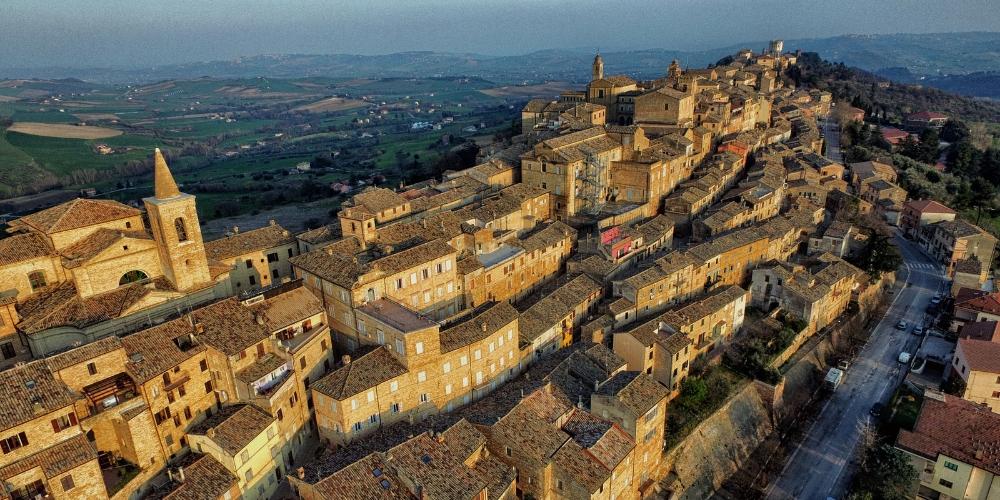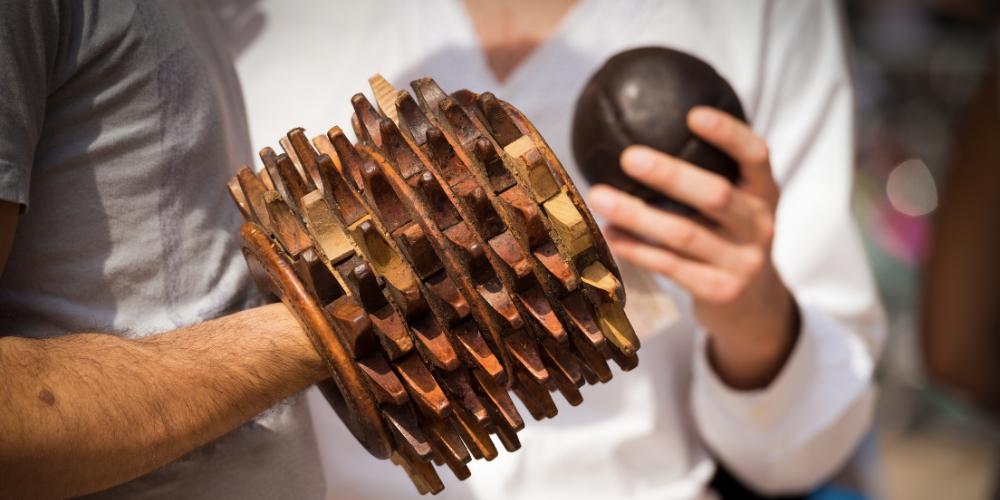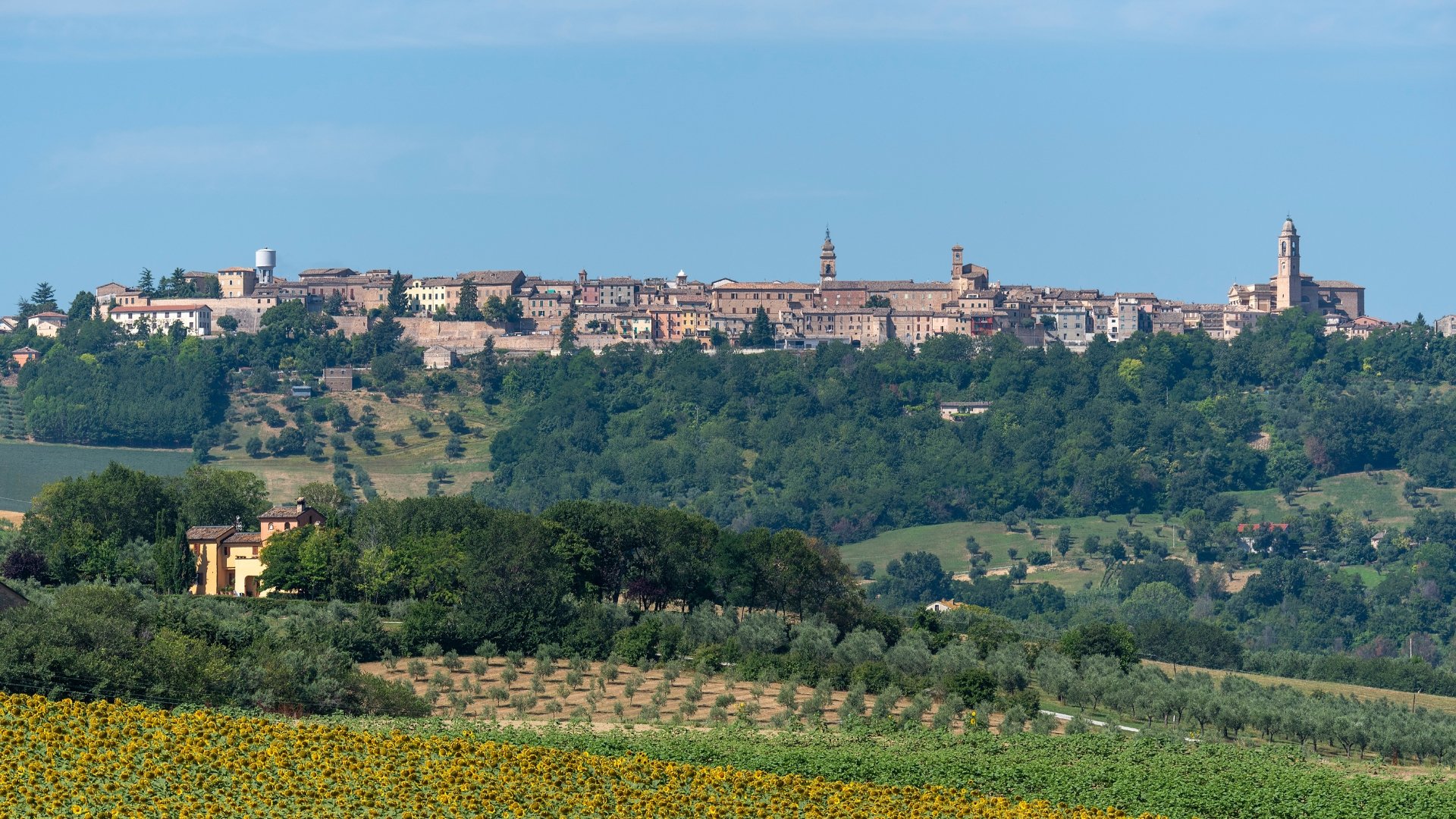It is one of the most beautiful villages in Italy and lies less than 20 kilometres from Macerata. Treia is a love of a small town with a delightful historic centre, an impressive panoramic terrace where the view stretches from the Adriatic Sea to the Sibillini Mountains, many artistic and cultural glimpses, and a special sports tradition.
Like Quidditch for Harry Potter, Il Gioco della Palla col Bracciale (Game of the Bracelet Ball) is a symbol of a distant world, which magically comes to life during the annual Disfida in July.
Also, in Treia you can savour the taste of the most authentic Marche life, a genuine atmosphere to breathe while walking through the village streets or enjoying la dolce vita seated at a restaurant table. Local gastronomy is marvellously surprising (get more surprises here)—calcione, the typical puff pastry filled with cheese, is a must-try for true connoisseurs.
Here is an overview of Treia. Consult it to discover what to see and do in a hidden gem near Macerata.

Treia, discover what to see

There are seven gates along the medieval walls. The city symbol, an imponent document of the time when Treia was still called Montecchio, is not far from Porta Palestro. The San Marco Tower is a scenic 12th-century crenellated turret that is the only 'survivor' of an ancient castle named after a Longobard princess, Onglavina.
Treia sits on a hill overlooking the valley of the Potenza river, which it colours with the soft amber shades of its buildings. The village's cobbled streets flank churches and sober, elegant dwellings, small squares, panoramic views and narrow alleys.
Among the most exciting points of interest is the Teatro Condominiale, which you reach by walking along the carvings and bas-reliefs that frame Corso Italia Libera. The richly decorated 19th-century theatre features a unique curtain evocative of the town's history.
In 1865, Silverio Copparoni depicted the Battle of Vallesacco, a well-known clash that took place at Porta Vallesacco, one of the entrances to Treia, in 1263.
While Piazza della Repubblica is its most renowned corner, this village has plenty of attractions.
In Contrada San Marco Vecchio, a massive oak was declared a national monument in 2000. 20-metre-tall Treia's Roverella is about 450 years old. A true honorary Treiese!
In the hamlet of Passo di Tria rises La Torre del Mulino. The tower, a small quadrangular defensive fortress, dates back to the 14th century.
Villa Spada, also known as Villa La Quiete, is among the most beautiful historic residences in the Marche region. A jewel of neoclassical architecture by Giuseppe Valadier, it can be visited by appointment.
In Contrada Fontevannazza, just outside the town, stands a 19th-century rural house made of unbaked earth, a rare example of humble and elementary construction widespread around the Abruzzo and Marche regions.
The Gothic church of San Francesco and the adjoining convent, which houses the Civic Archaeological Museum with its collection of Egyptian and Roman artefacts, are worth a visit. This 'exotic' fact should come as no surprise since the cult of the Egyptian divinities Isis and Serapis was widespread in the Treia area in ancient times.
The great Santuario del Santissimo Crocifisso is also an excellent stop. You find it just outside the residential area and preserves a 15th-century crucifix attributed to Donatello.
Need more info about Treia? Then you should definitely check Marche Tourism, but wait to click: our journey is still ongoing.
Treia and its Piazza della Repubblica
Piazza della Repubblica is Treia's 'living room'. This ample horseshoe-shaped square opens on a panoramic terrace with a view embracing Mount Conero Mountain and the Adriatic. What catches the eye is the 18th-century marble balustrade, a stunning balcony over the fields and hills of the Marche region.
La piazza is the beating heart of Treia and boasts several valuable elements. The beautiful blue marble fountain in the centre is surrounded on three sides by the Church of San Filippo Neri, the Palazzo Comunale, home to the Civic Museum, and the Accademia Georgica.
The latter, an 18th-century building by Valadier, contains around 14,000 volumes and houses the Municipal Historical Archives, among the oldest and most well-stocked in the Marche region.
Just a few steps away, the church Santissima Annunziata, Treia's cathedral, is sparkling with artistic treasures such as the altarpiece by Giacomo da Recanati.
Treia and its special competition

An ancient sport, popular in Italy until the beginning of the 20th century, in which the four districts of Treia (Vallesacco, Onglavina, Borgo and Cassero) challenge each other. Il Gioco del Pallone col Bracciale is the symbol discipline in town, a practice that has survived the centuries and changes in customs, habits and passions.
Carlo Didimi was its spokesman and most celebrated player (celebrated even by the great Marchigiano poet Giacomo Leopardi). Treia's arena (sferisterio) is dedicated to this sort of Lionel Messi in his field and annually hosts the so-called Disfida del Bracciale.
What is it all about? It's a national tournament somewhere between a sporting event and a historical commemoration. The event occurs after ten days of celebrations in a colourful succession of shows, music and entertainment between July and August.
Inevitably, a place that so proudly carries on its traditions cannot miss a museum honouring the sport the town is so fond of. Il Museo Gioco del Pallone col Bracciale is set up with photos, posters, trophies, cups, armbands and balls from the 19th century to the present day.
About the author
Written on 30/12/2022



Lorena Calise
Welcome to Treia, a village of beauty, flavours and yesteryear sports.